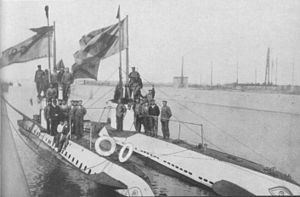
Back الغواصة الألمانية فئة يو بي 1 Arabic Třída UB I Czech زیردریایی تیپ یوبی اول Persian Unterseeboot type UB I French Podmornice klase UB I Croatian U-Boot Tipo UB I Italian Okręty podwodne typu UB I Polish Подводные лодки типа UB-I Russian UB I tipi denizaltı Turkish UB-I型潜艇 Chinese
 SM UB-2 and SM UB-16 in Flanders. | |
| Class overview | |
|---|---|
| Builders | |
| Operators | |
| Preceded by | Type UA |
| Succeeded by | Type UB II |
| Built | 1914–1915[4] |
| In commission | 1915–1918 |
| Completed | 20[1][2] |
| Lost | 10[2][6][a] |
| Scrapped | 10[1][2][3] |
| General characteristics | |
| Type | coastal midget submarine[1] |
| Displacement | |
| Length |
|
| Beam | 3.15 m (10 ft 4 in) |
| Height | 7.30 m (23 ft 11 in)[7] |
| Draught | 3.03 m (9 ft 11 in) |
| Propulsion |
|
| Speed | |
| Range |
|
| Test depth | 50 metres (160 ft)[1] |
| Complement | 14[1][8] |
| Armament |
|
| Notes | 33-second diving time[1] |
The Type UB I submarine (sometimes known as the UB-1 class[5]) was a class of small coastal submarines (U-boats) built in Germany at the beginning of the First World War. Twenty boats were constructed, most of which went into service with the German Imperial Navy (Kaiserliche Marine) Boats of this design were also operated by the Austro-Hungarian Navy (Kaiserliche und Königliche Kriegsmarine or K.u.K. Kriegsmarine) and the Bulgarian Navy. In the Austro-Hungarian Navy, it was called the U-10 class.
Built to meet the need for small maneuverable submarines able to operate in the narrow, shallow seas off Flanders, the vessels were intended to be quickly constructed, then shipped by rail and assembled at their port of operation. The design effort began in mid-August 1914 and by mid-October the first 15 boats were ordered from two German shipyards. The German Imperial Navy subsequently ordered an additional pair of boats to replace two sold to Austria-Hungary, who ordered a further three boats in April 1915 for a total of 20 UB Is built.
Construction of the first boats for Germany began in early November 1914; all 20 were completed by October 1915. Several of the first boats underwent trials in German home waters, but the rest were assembled and tested at either Antwerp or Pola. The German boats operated primarily in the Flanders, Baltic, and Constantinople Flotillas. The boats were about 28 metres (92 ft) long and displaced 127 tonnes (125 long tons) when surfaced and 142 tonnes (140 long tons) while submerged. All had two bow torpedo tubes and two torpedoes, and were equipped with a deck-mounted machine gun.
In 1918 four of the surviving German boats were converted into coastal minelayers. Of the seventeen boats in German service, two were sold to Austria-Hungary, one was sold to Bulgaria, and nine were lost during the war. One of the five Austro-Hungarian boats was sunk and another mined and not repaired. The five surviving German boats, the four surviving Austro-Hungarian boats, and the Bulgarian boat were all turned over to the Allies after the end of the war and were broken up.
- ^ a b c d e f g h i j k Gardiner, p. 180.
- ^ a b c d e Gardiner, p. 343.
- ^ a b Gardiner, p. 412.
- ^ Gardiner, pp. 173, 180
- ^ a b c d e f g h Tarrant, p. 172.
- ^ a b Messimer, pp. 127–36
- ^ Helgason, Guðmundur. "WWI U-boat Types: Type UB I". German and Austrian U-boats of World War I - Kaiserliche Marine - Uboat.net. Retrieved 26 January 2010.
- ^ a b c Messimer, p. 7.
- ^ Gröner 1991, pp. 22–23.
- ^ Jung, p. 42.
Cite error: There are <ref group=lower-alpha> tags or {{efn}} templates on this page, but the references will not show without a {{reflist|group=lower-alpha}} template or {{notelist}} template (see the help page).